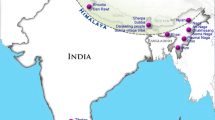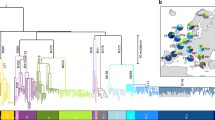Abstract
Genetic, ethnographic, and historical evidence suggests that the Hindu castes have been highly endogamous for several thousand years and that, when movement between castes does occur, it typically consists of females joining castes of higher social status. However, little is known about migration rates in these populations or the extent to which migration occurs between caste groups of low, middle, and high social status. To investigate these aspects of migration, we analyzed the largest collection of genetic markers collected to date in Hindu caste populations. These data included 45 newly typed autosomal short tandem repeat polymorphisms (STRPs), 411 bp of mitochondrial DNA sequence, and 43 Y-chromosomal single-nucleotide polymorphisms that were assayed in more than 200 individuals of known caste status sampled in Andrah Pradesh, in South India. Application of recently developed likelihood-based analyses to this dataset enabled us to obtain genetically derived estimates of intercaste migration rates. STRPs indicated migration rates of 1–2% per generation between high-, middle-, and low-status caste groups. We also found support for the hypothesis that rates of gene flow differ between maternally and paternally inherited genes. Migration rates were substantially higher in maternally than in paternally inherited markers. In addition, while prevailing patterns of migration involved movement between castes of similar rank, paternally inherited markers in the low-status castes were most likely to move into high-status castes. Our findings support earlier evidence that the caste system has been a significant, long-term source of population structuring in South Indian Hindu populations, and that patterns of migration differ between males and females.

Similar content being viewed by others
References
Andrews RM, Kubacka I, Chinnery PF, Lightowlers RN, Turnbull DM, Howell N (1999) Reanalysis and revision of the Cambridge reference sequence for human mitochondrial DNA. Nat Genet 23:147
Balakrishnan V (1978) A preliminary study of genetic distances among some populations of the Indian sub-continent. J Hum Evol 7:67–75
Bamshad MJ, Fraley AE, Crawford MH, Cann RL, Busi BR, Naidu JM, Jorde LB (1996) mtDNA variation in caste populations of Andhra Pradesh, India. Hum Biol 68:1–28
Bamshad MJ, Watkins WS, Dixon ME, Jorde LB, Rao BB, Naidu JM, Prasad BVR, Rasanayagam A, Hammer MF (1998) Female gene flow stratifies hindu castes. Nature 395:651–652
Bamshad MJ, Kivisild T, Watkins WS, Dixon ME, Ricker CE, Rao BB, Naidu JM, Prasad BVR, Reddy PG, Rasanayagam A, Papiha SS, Villems R, Redd AJ, Hammer MF, Nguyen SV, Carroll ML, Batzer MA, Jorde LB (2001) Genetic evidence on the origins of Indian caste populations. Genome Res 11:994–1004
Basu A, Mukherjee N, Roy S, Sengupta S, Banerjee S, Chakraborty M, Dey B, Roy M, Roy B, Bhattacharyya NP, Roychoudhury S, Majumder PP (2003) Ethnic India: a genomic view, with special reference to peopling and structure. Genome Res 13:2277–2290
Beals AR (1962) Gopalpur: a South Indian village. Holt, Rhinehart and Winston, New York
Beerli P (2001) Migrate documentation and program, Version 1.1. Computer program distributed by the author, Department of Genetics, University of Washington, Seattle
Beerli P, Felsenstein J (1999) Maximum-likelihood estimation of migration rates and effective population numbers in two populations using a coalescent approach. Genetics 152:763–773
Beerli P, Felsenstein J (2001) Maximum likelihood estimation of a migration matrix and effective population sizes in n subpopulations by using a coalescent approach. Proc Natl Acad Sci USA 98:4563–4568
Berdan FF (1982) The Aztecs of Central Mexico. Harcourt, Brace and Company, Orlando
Bhattacharyya NP, Basu P, Das M, Pramanik S, Banerjee R, Roy B, Roychoudhury S, Majumder PP (1999) Negligible male gene flow across ethnic boundaries in India, revealed by analysis of Y-chromosomal DNA polymorphisms. Genome Res 9:711–719
Brinkmann B, Klintschar M, Neuhuber F, Hühne J, Rolf B (1998) Mutation rate in human microsatellites: influence of the structure and length of the tandem repeat. Am J Hum Genet 62:1408–1415
Chakraborty R, Chakravarti A, Malhotra KC (1977) Variation in allele frequencies among caste groups of the Dhangars of Maharashtra, India: an analysis with Wright’s FST statistic. Ann Hum Biol 4:275–280
Chakraborty R, Walter H, Mukherjee BN, Malhotra KC, Sauber P, Banerjee S, Roy M (1986) Gene differentiation among ten endogamous groups of West Bengal, India. Am J Phys Anthropol 71:295–309
Char KS, Lakshmi P, Gopalam KB, Sastry JG, Rao PR (1989) Genetic differentiation among some endogamous populations of Andhra Pradesh, India. Am J Phys Anthropol 78:421–429
Dobzhansky T (1973) Genetic diversity and human equality. Basic Books, New York
Dutta R, Reddy BM, Chattopadhyay P, Kashyap VK, Sun G, Deka R (2002) Patterns of genetic diversity at the nine forensically approved STR loci in the Indian populations. Hum Biol 74:33–49
Gresham D, Morar B, Underhill PA, Passarino G, Lin AA, Wise C, Angelicheva D, Calafell F, Oefner PJ, Shen P, Tournev I, de Pablo R, Kuĉinskas V, Perez-Lezaun A, Marushiakova E, Popov V, Kalaydjieva L (2001) Origins and divergence of the Roma (Gypsies). Am J Hum Genet 69:1314–1331
Hammer MF, Karafet TM, Redd AJ, Jarjanazi H, Santachiara-Benerecetti S, Soodyall H, Zegura SL (2001) Hierarchical patterns of global human Y-chromosome diversity. Mol Biol Evol 18:1189–1203
Heinz CB (1999) Asian cultural traditions. Waveland Press, Prospect Heights
Jorde LB, Watkins WS, Bamshad MJ, Dixon ME, Ricker CE, Sielstad MT, Batzer MA (2000) The distribution of human genetic diversity: a comparison of mitochondrial, autosomal and Y-chromosome data. Am J Hum Genet 66:979–988
Jorde LB, Bamshad MJ, Watkins WS, Ricker CE, Dixon ME, Rao BB, Prasad BVR, Naidu JM (2002) Genetic structure of South Indian caste populations: a confluence of biology and culture. In: Macbeth H, Collinson P (eds) Human population dynamics: cross-disciplinary perspective. Cambridge University Press, Cambridge
Karve I (1968) Kinship organization in India. Asia Publishing House, Bombay
Krishnan T, Reddy BM (1994) Geographical and ethnic variability of finger ridge-counts: biplots of male and female Indian samples. Ann Hum Biol 21:155–169
Kuhner M, Beerli P, Yamato J, Felsenstein J (2000) Usefulness of single-nucleotide polymorphism data for estimating population parameters. Genetics 156:439–447
Lakshmi N, Demarchi DA, Veerraju P, Rao TV (2002) Population structure and genetic differentiation among the substructured Vysya caste population in comparison to the other populations of Andhra Pradesh, India. Ann Hum Biol 29:538–539
Leopoldino AM, Pena SDJ (2002) The mutational spectrum of human autosomal tetranucleotide microsatellites. Hum Mutat 21:17–79
Majumder PP (1998) People of India: biological diversity and affinities. Evol Anthrobol 6:100–110
Majumder PP (2001) Indian caste origins: genomic insights and future outlook. Genome Res 11:931–932
Majumder PP, Roy B, Banerjee S, Chakraborty M, Dey B, Mukherjee N, Roy M, Thakurta PG, Sil SK (1999) Human-specific insertion/deletion polymorphisms in Indian populations and their possible evolutionary implications. Eur J Hum Genet 7:435–446
Malhotra KC, Vasulu TS (1993) Structure of human populations in India. In: Majumder PP (ed) Human population genetics. Plenum, New York, pp 207–233
Misra VN (2001) Prehistoric human colonization of India. J Biosci 26:491–531
Mountain JL, Hebert JM, Bhattacharyya S, Underhill PA, Ottolenghi C, Gadgil M, Cavalli-Sforza LL (1995) Demographic history of India and mtDNA sequence diversity. Am J Hum Genet 56:979–992
Mukherjee BN, Majumder PP, Roy B, Roy M, Dey B, Chakraborty M, Banerjee S (1999) Variation at 4 short tandem repeat loci in 8 population groups of India. Hum Biol 71:439–446
Papiha SS, Mastana SS, Purandare CA, Jayasekara R, Chakraborty R (1996) Population genetic study of three VNTR loci (D2S44, D7S22, and D12S11) in five ethnically defined populations of the Indian subcontinent. Hum Biol 68:819–835
Passarino G, Semino O, Bernini LF, Santachiara-Benerecetti AS (1996) Pre-caucasoid and Caucasoid genetic features of the Indian population, revealed by mtDNA polymorphisms. Am J Hum Genet 59:927–934
Pritchard JK, Przeworski M (2001) Linkage disequilibrium in humans: models and data. Am J Hum Genet 69:1–14
Roychoudhury AK (1982) Genetic relationships of Indian populations. In: Malhotra KC, Basu A (eds) Human genetics and adaptation. Plenum, New York, pp 147–174
Roychoudhury S, Roy S, Dey B, Chakraborty M, Roy M, Roy B, Ramesh A, Prabhakaran N, Rani MVU, Vishwanathan H, Mitra M, Sil SK, Majumder PP (2000) Fundamental genomic unity of ethnic India is revealed by analysis of mitochondrial DNA. Curr Sci 79:1182–1192
Slatkin M (1991) Inbreeding coefficients and coalescence times. Genet Res Camb 58:167–175
Slatkin M (1995) A measure of population subdivision based on microsatellite allele frequencies. Genetics 139:457–462
Tambia SJ (1973) The character of kinship. Cambridge University Press, Cambridge
Tishkoff SA, Verrelli BC (2003) Patterns of human genetic diversity: implications for human evolutionary history and disease. Annu Rev Genom Hum Genet 4:293–340
Tuden A, Plotnicov L (1970) Social stratification in Africa. The Free Press, New York
Watkins WS, Bamshad M, Dixon ME, Rao BB, Naidu JM, Reddy PG, Prasad BV, Das PK, Gai PB, Bhanu A, Kusuma YS, Lum JK, Fischer P, Jorde LB (1999) Multiple origins of the mtDNA 9-bp deletion in populations of South India. Am J Phys Anthrobol 109:147–158
Watkins WS, Rogers AR, Ostler CT, Wooding S, Bamshad MJ, Brassington AM, Carroll ML, Nguyen SV, Walker JA, Batzer MA, Prasad BVR, Reddy G, Das PK, Jorde LB (2003) Genetic variation among world populations: inferences from 100 Alu insertion polymorphisms. Genome Res 13:1607–1618
Weber JL, Wong C (1993) Mutation of human short tandem repeats. Hum Mol Genet 2:1123–1128
Author information
Authors and Affiliations
Corresponding author
Rights and permissions
About this article
Cite this article
Wooding, S., Ostler, C., Prasad, B.V.R. et al. Directional migration in the Hindu castes: inferences from mitochondrial, autosomal and Y-chromosomal data. Hum Genet 115, 221–229 (2004). https://doi.org/10.1007/s00439-004-1130-x
Received:
Accepted:
Published:
Issue Date:
DOI: https://doi.org/10.1007/s00439-004-1130-x




